Books are not flat ...
From a technical point of view, books are the worst objects to scan, and if they were invented today, they would be infinitely long scrolls. If this had happened, there would be no need for planetary scanners at all.
Today we will talk about the characteristics of planetary scanners, the parameters that determine and justify the existence of this type of equipment in this world. Planetary scanners are designed for contactless high-quality digitization of a variety of originals: stitched and embroidered documents, documents with a thick spine, valuable, old; as well as fabrics, orders, coins, etc. The planetary (projection) scanning method is scanning from top to bottom, so to speak, from the head.
Gaze
')
From the inside, the scanning “head” looks like this:
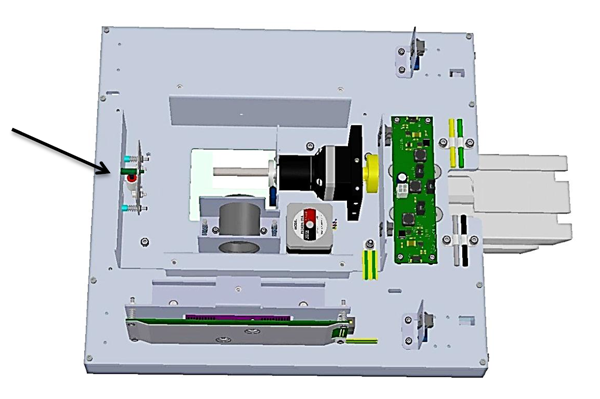
It contains one or several photosensitive sensors, an optical system with a focus adjustment drive, and a control controller. In some models, there is a laser rangefinder module and a drive control of the “tracking” lighting system, as well as brains. However, in the scanner the most important thing is still not the brain, but the “eyes”.
The word "scan" (English scanner, from scan "intently examine, examine") implies the primacy of the value of the actual scanning element. It is customary to distinguish between scanning elements with a linear CCD-sensor and a matrix. "CCD-sensor" (abbr. From the English. CCD, "Charge-CoupledDevice") or "CCD-matrix" (abbr. From the "charge-coupled device"). Planetary scanners based on digital cameras should be highlighted in a separate group. They have one or two digital cameras as a scanning element.
"We are loaded into the matrix"
In the product line of ELAR Corporation scanners there is equipment with a digital camera with a CMOS matrix , scanners based on a matrix CCD sensor and on the basis of a linear CCD sensor .

Scanners based on digital cameras have one focal plane, and many objects in a digital image are out of focus, which leads to a deterioration in overall clarity. However, looking ahead, we will say that in the fall we will present a scanner model based on a camera with the ability to adjust the focus ring. For “fixed” high-resolution digital cameras, the exposure time (exposure) is about a second, which makes them very sensitive to all types of movements. Missing color components are calculated by the processor based on data from neighboring pixels as a result of interpolation, which entails new color distortions. In addition, it is worth noting the geometric distortions when scanning in the V-shaped mode.
Scanner cameras with a CCD sensor do not have focus problems. With scanning technology, the exposure time is much less (in the range of 250 ... 1500 μs (10-6)). Scanning creates many thousands of images per second — uneven movement of the original or vibrations have little effect on the final result. If the scanner can scan in the horizontal direction, as well as constantly changing the focal length and resolution while moving along a curved surface, it can be used to scan flat documents, open books, and even incompletely open books on a V-shaped stand.
An important characteristic when classifying scanners is the scanning speed. Manufacturers of planetary scanners with CCD optics can afford to talk about the speed of scanning a full cycle (actually scanning, processing and transmission of the image), which is measured in seconds. Scanning speed when working on planetary scanners with a digital camera is only the speed of clicking the shutter.
A separate topic is the determination of the real resolution of the scanner according to the so-called “minimum limit readable group”. We will touch on it in one of the following posts, when we talk in detail about the device of scanning elements in planetary scanners.
Cradle for the image
Planetary scanners also differ in the type of book cradles. The book cradle consists of two independent parts, adjustable for a given format, thickness and weight of the digitized object.
The cradles can be manual or have a motorized drive, and parts of the cradle take an independent position relative to each other, adjusting to the different thickness of the scanned originals. It is worth noting especially the cradle, which provides the possibility of their disclosure at a given angle, the so-called V-shaped - they are used to work with shabby originals or rare originals, which can not be fully disclosed.
A special role is played by the cradle in the scanners, when it is necessary to avoid the exposure of the original. In the photo you see the process of scanning a glossy surface and a side effect - glare on the scan image.

Specialized software built into the scanner partially removes light from the electronic image:

To save a scanned copy of the glare elements, the book cradle allows:

To obtain the highest quality and smooth image, some scanners are equipped with pressure glass. It can be both flat and V-shaped, with both manual and automated lifting mechanism.

About brains ...
Planetary scanners can function as peripheral devices when you need a direct connection to a computer, and can be standalone. The advantages of the latter are obvious: in addition to saving energy, this means fewer pieces of equipment on the balance sheet of the enterprise, lower maintenance costs, etc. In stand-alone scanners, all processing of scanned images takes place inside the device due to the full built-in computer. The full cycle of scanning, transmitting, processing and saving images on scanners of the first and second types looks like this:
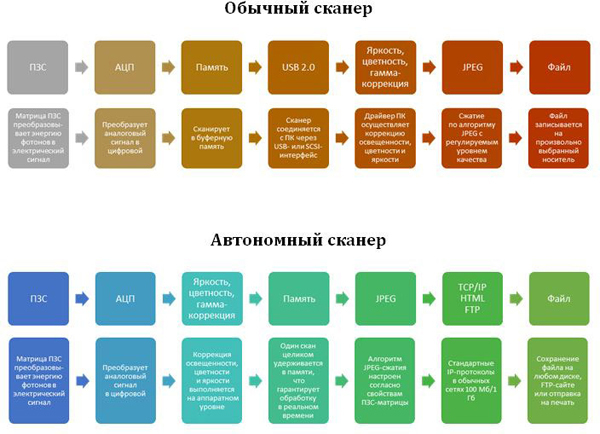
There are many other characteristics of planetary scanners, such as: control interface, image processing firmware, dimensions, weight, additional options, lighting system. The latter is classified according to the type of lamps used: fluorescent - harmful, and LED, which, on the contrary, do not affect the originals and the operator's eyes with ultraviolet and infrared radiation.
But the most important thing in the scanner is still the “head” and its filling. The device of the “head” of the scanner at 2/3 determines the cost of the equipment, and to a much greater degree than all the other parameters, it influences the choice of model depending on the tasks of the customer. According to their intended purpose, the scanners can be divided into three groups - self-service terminals, universal devices and stream digitization stations.
Hard worker
"In his entire life, he will prepare several hundred preparations of extraordinary purity, write many dry, very decent abstracts, make about a dozen faithful translations, but will not invent gunpowder ...". If you compare the scanner with the type of professional in any field, then this quote from Chekhov's story very accurately describes the self-service terminal . It is equipped with a digital camera based on CMOS matrix. It is intended for private use in the public area, a use in which the creation of an impeccable electronic image of the original is by no means the main thing.
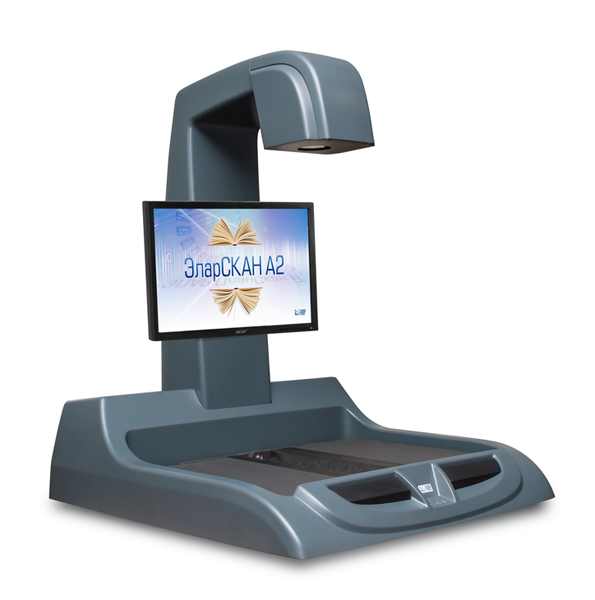
However, it is an independent device that can work without being connected to a workstation and provides fast scanning and data transfer. Electronic images are saved directly to the network (to an employee’s personal station or server) or to a USB drive. You can restrict user access to the terminal by entering a password. Supports adding tags to a graphic image to protect against unauthorized use and copying, and it is possible to provide personalized access to the scanner with individual user settings using smart cards and an optional RFID tag reader.
Universal Soldier
Universal devices are used to create electronic collections of book collections, periodicals, photo albums and other documents; they can serve as a self-scanning point for a wide range of users, as a system of stream digitization.
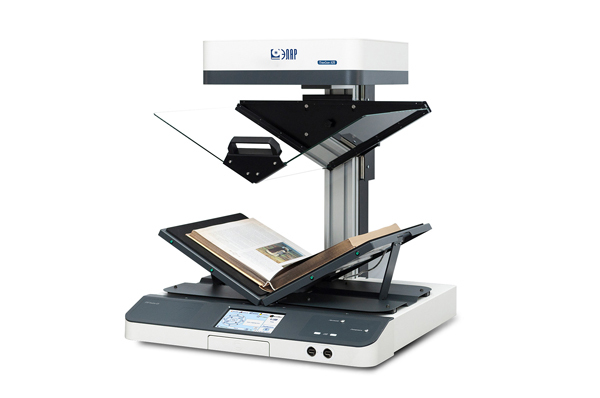
The scanner is equipped with CCD-based optics, scanning is carried out in the horizontal direction (along the “short side”). The optical resolution of the scanner is 600 dpi. A “tracking” LED backlight without ultraviolet and infrared radiation is built into the head of the scanner. The scanner provides the readability of the marginal group with the spatial frequency of lines 5,6 of the resolution test object, made according to GOST 13.1.701-87.
You can put a book in the book cradle, the spine thickness of which is 150 mm. The cradle is adjustable in width and transforms into two positions: 120 and 180 degrees. On the scanner, you can digitize stitched documents with incomplete disclosure in the V-shaped mode. V-shaped hold-down glass is easy to install and dismantle.

This is a standalone network scanner that does not require a connection to the control workstation. It operates under the control of software that allows it to be used as a network device with a Gigabit Ethernet interface, which makes it possible to save scanned images to any computer that is accessible on the network, to mobile devices, and also to carry out remote diagnostics, configuration and updating by service departments.

In 2013, the Universal Soldier was delivered to more than 170 Russian organizations. Libraries, archives and museums use it to create digital collections and electronic funds for use. Libraries and universities need a device as a complex of self-scanning (KCC). Modification of the scanner for this purpose involves the “implantation” of the RFID reader, the transformation of the touch control panel, the presence of a coin acceptor. The RFID reader identifies users by electronic map and registers the document. The system conducts a dialogue with the user: the control panel reports the balance (if the provision of self-scanning services for a fee is provided), displays information about the user and the selected document. In cases where KCC is used in the library and university areas, the system allows you to monitor the reader’s compliance with copyright laws with the appropriate warning on the terminal screen and mandatory personal compliance with the rules.
Thanks to the universality of this particular scanner, today a long-standing stereotype of the perception of planet-owners as a device relevant only to cultural institutions that need to scan books is being destroyed. For ships, departments and commercial organizations, this scanner is a device for stream digitization. Companies integrate planetary scanners into their IT infrastructure and, among other things, solve the task of monitoring scans. In geographically distant digitization centers of the world justice bodies, court cases are transferred to electronic form, which are stored in a single electronic archive.
Great swimming
With the help of equipment based on the matrix CCD-sensor, electronic collections and funds are created for using any documents in streaming mode. The main advantages of such scanners are the high quality of the images and performance.
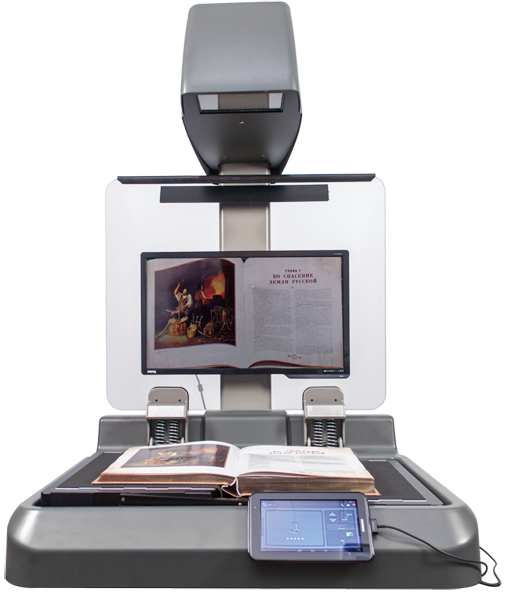
The scanner creates an image of 400 dpi in 3, 4 seconds in color mode. The sensor independently "reacts" to the page turn, that is, digitization is carried out semi-automatically. The scanner has a book cradle that allows you to scan books up to 10 cm thick and weighing up to 10 kg, ensuring the placement of pages in one plane. The cradle also provides the ability to scan a very wide range of objects - folios, albums, document filings, folders, drawings, maps, paintings, posters, books with various spines, any volume objects within the scope of the scanning area and the autofocus range. The device can be equipped with a reinforced book cradle for stitched originals up to 50 cm thick and weighing up to 50 kg .
Equipment, in any of its configuration, is acquired mainly by archives, museums and libraries. In addition, these scanners were used, for example, to create the largest digital resource in the country , when more than 13.7 million sheets of archival documents and over 42 thousand passports of military graves were scanned.
Today we will talk about the characteristics of planetary scanners, the parameters that determine and justify the existence of this type of equipment in this world. Planetary scanners are designed for contactless high-quality digitization of a variety of originals: stitched and embroidered documents, documents with a thick spine, valuable, old; as well as fabrics, orders, coins, etc. The planetary (projection) scanning method is scanning from top to bottom, so to speak, from the head.
Gaze
')
From the inside, the scanning “head” looks like this:

It contains one or several photosensitive sensors, an optical system with a focus adjustment drive, and a control controller. In some models, there is a laser rangefinder module and a drive control of the “tracking” lighting system, as well as brains. However, in the scanner the most important thing is still not the brain, but the “eyes”.
The word "scan" (English scanner, from scan "intently examine, examine") implies the primacy of the value of the actual scanning element. It is customary to distinguish between scanning elements with a linear CCD-sensor and a matrix. "CCD-sensor" (abbr. From the English. CCD, "Charge-CoupledDevice") or "CCD-matrix" (abbr. From the "charge-coupled device"). Planetary scanners based on digital cameras should be highlighted in a separate group. They have one or two digital cameras as a scanning element.
"We are loaded into the matrix"
In the product line of ELAR Corporation scanners there is equipment with a digital camera with a CMOS matrix , scanners based on a matrix CCD sensor and on the basis of a linear CCD sensor .

Scanners based on digital cameras have one focal plane, and many objects in a digital image are out of focus, which leads to a deterioration in overall clarity. However, looking ahead, we will say that in the fall we will present a scanner model based on a camera with the ability to adjust the focus ring. For “fixed” high-resolution digital cameras, the exposure time (exposure) is about a second, which makes them very sensitive to all types of movements. Missing color components are calculated by the processor based on data from neighboring pixels as a result of interpolation, which entails new color distortions. In addition, it is worth noting the geometric distortions when scanning in the V-shaped mode.
Scanner cameras with a CCD sensor do not have focus problems. With scanning technology, the exposure time is much less (in the range of 250 ... 1500 μs (10-6)). Scanning creates many thousands of images per second — uneven movement of the original or vibrations have little effect on the final result. If the scanner can scan in the horizontal direction, as well as constantly changing the focal length and resolution while moving along a curved surface, it can be used to scan flat documents, open books, and even incompletely open books on a V-shaped stand.
An important characteristic when classifying scanners is the scanning speed. Manufacturers of planetary scanners with CCD optics can afford to talk about the speed of scanning a full cycle (actually scanning, processing and transmission of the image), which is measured in seconds. Scanning speed when working on planetary scanners with a digital camera is only the speed of clicking the shutter.
A separate topic is the determination of the real resolution of the scanner according to the so-called “minimum limit readable group”. We will touch on it in one of the following posts, when we talk in detail about the device of scanning elements in planetary scanners.
Cradle for the image
Planetary scanners also differ in the type of book cradles. The book cradle consists of two independent parts, adjustable for a given format, thickness and weight of the digitized object.
The cradles can be manual or have a motorized drive, and parts of the cradle take an independent position relative to each other, adjusting to the different thickness of the scanned originals. It is worth noting especially the cradle, which provides the possibility of their disclosure at a given angle, the so-called V-shaped - they are used to work with shabby originals or rare originals, which can not be fully disclosed.
A special role is played by the cradle in the scanners, when it is necessary to avoid the exposure of the original. In the photo you see the process of scanning a glossy surface and a side effect - glare on the scan image.

Specialized software built into the scanner partially removes light from the electronic image:

To save a scanned copy of the glare elements, the book cradle allows:

To obtain the highest quality and smooth image, some scanners are equipped with pressure glass. It can be both flat and V-shaped, with both manual and automated lifting mechanism.

About brains ...
Planetary scanners can function as peripheral devices when you need a direct connection to a computer, and can be standalone. The advantages of the latter are obvious: in addition to saving energy, this means fewer pieces of equipment on the balance sheet of the enterprise, lower maintenance costs, etc. In stand-alone scanners, all processing of scanned images takes place inside the device due to the full built-in computer. The full cycle of scanning, transmitting, processing and saving images on scanners of the first and second types looks like this:

There are many other characteristics of planetary scanners, such as: control interface, image processing firmware, dimensions, weight, additional options, lighting system. The latter is classified according to the type of lamps used: fluorescent - harmful, and LED, which, on the contrary, do not affect the originals and the operator's eyes with ultraviolet and infrared radiation.
But the most important thing in the scanner is still the “head” and its filling. The device of the “head” of the scanner at 2/3 determines the cost of the equipment, and to a much greater degree than all the other parameters, it influences the choice of model depending on the tasks of the customer. According to their intended purpose, the scanners can be divided into three groups - self-service terminals, universal devices and stream digitization stations.
Hard worker
"In his entire life, he will prepare several hundred preparations of extraordinary purity, write many dry, very decent abstracts, make about a dozen faithful translations, but will not invent gunpowder ...". If you compare the scanner with the type of professional in any field, then this quote from Chekhov's story very accurately describes the self-service terminal . It is equipped with a digital camera based on CMOS matrix. It is intended for private use in the public area, a use in which the creation of an impeccable electronic image of the original is by no means the main thing.

However, it is an independent device that can work without being connected to a workstation and provides fast scanning and data transfer. Electronic images are saved directly to the network (to an employee’s personal station or server) or to a USB drive. You can restrict user access to the terminal by entering a password. Supports adding tags to a graphic image to protect against unauthorized use and copying, and it is possible to provide personalized access to the scanner with individual user settings using smart cards and an optional RFID tag reader.
Universal Soldier
Universal devices are used to create electronic collections of book collections, periodicals, photo albums and other documents; they can serve as a self-scanning point for a wide range of users, as a system of stream digitization.

The scanner is equipped with CCD-based optics, scanning is carried out in the horizontal direction (along the “short side”). The optical resolution of the scanner is 600 dpi. A “tracking” LED backlight without ultraviolet and infrared radiation is built into the head of the scanner. The scanner provides the readability of the marginal group with the spatial frequency of lines 5,6 of the resolution test object, made according to GOST 13.1.701-87.
You can put a book in the book cradle, the spine thickness of which is 150 mm. The cradle is adjustable in width and transforms into two positions: 120 and 180 degrees. On the scanner, you can digitize stitched documents with incomplete disclosure in the V-shaped mode. V-shaped hold-down glass is easy to install and dismantle.

This is a standalone network scanner that does not require a connection to the control workstation. It operates under the control of software that allows it to be used as a network device with a Gigabit Ethernet interface, which makes it possible to save scanned images to any computer that is accessible on the network, to mobile devices, and also to carry out remote diagnostics, configuration and updating by service departments.

In 2013, the Universal Soldier was delivered to more than 170 Russian organizations. Libraries, archives and museums use it to create digital collections and electronic funds for use. Libraries and universities need a device as a complex of self-scanning (KCC). Modification of the scanner for this purpose involves the “implantation” of the RFID reader, the transformation of the touch control panel, the presence of a coin acceptor. The RFID reader identifies users by electronic map and registers the document. The system conducts a dialogue with the user: the control panel reports the balance (if the provision of self-scanning services for a fee is provided), displays information about the user and the selected document. In cases where KCC is used in the library and university areas, the system allows you to monitor the reader’s compliance with copyright laws with the appropriate warning on the terminal screen and mandatory personal compliance with the rules.
Thanks to the universality of this particular scanner, today a long-standing stereotype of the perception of planet-owners as a device relevant only to cultural institutions that need to scan books is being destroyed. For ships, departments and commercial organizations, this scanner is a device for stream digitization. Companies integrate planetary scanners into their IT infrastructure and, among other things, solve the task of monitoring scans. In geographically distant digitization centers of the world justice bodies, court cases are transferred to electronic form, which are stored in a single electronic archive.
Great swimming
With the help of equipment based on the matrix CCD-sensor, electronic collections and funds are created for using any documents in streaming mode. The main advantages of such scanners are the high quality of the images and performance.

The scanner creates an image of 400 dpi in 3, 4 seconds in color mode. The sensor independently "reacts" to the page turn, that is, digitization is carried out semi-automatically. The scanner has a book cradle that allows you to scan books up to 10 cm thick and weighing up to 10 kg, ensuring the placement of pages in one plane. The cradle also provides the ability to scan a very wide range of objects - folios, albums, document filings, folders, drawings, maps, paintings, posters, books with various spines, any volume objects within the scope of the scanning area and the autofocus range. The device can be equipped with a reinforced book cradle for stitched originals up to 50 cm thick and weighing up to 50 kg .
Equipment, in any of its configuration, is acquired mainly by archives, museums and libraries. In addition, these scanners were used, for example, to create the largest digital resource in the country , when more than 13.7 million sheets of archival documents and over 42 thousand passports of military graves were scanned.
Source: https://habr.com/ru/post/229973/
All Articles